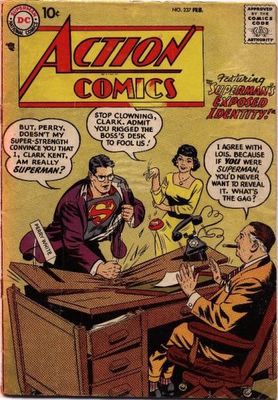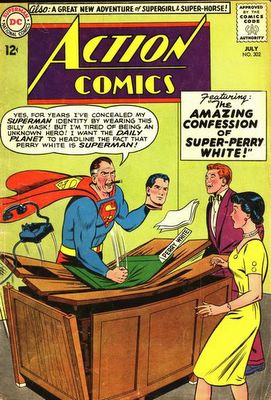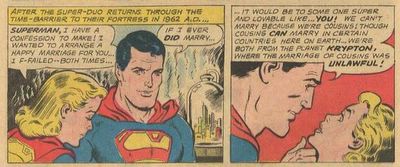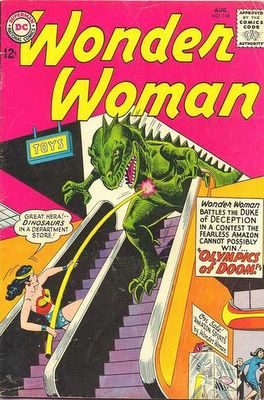In Part I of my post on J'onn J'onzz, the Martian Manhunter, I discussed some of his early exploits and powers. In this post I'll focus in on some key Detective issues in his history.
First, obviously, is Detective #225, where MM makes his first appearance, discussed extensively in the prior post.
In Detective #246 we are given our first introduction to lovely redhead (later blonde) Diane Meade. She is a trainee police officer but also the daughter of the Police Comissioner. As a trainee she makes Detective Jones miserable, since she's always asking questions about his methods, and he can't reveal he's using his Martian powers. At the end of the case, Jones muses to himself about the sparkle he noted in Diane's eyes when she looked at him.
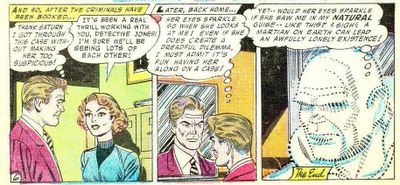
A pretty interesting ending to the story, eh? Remember, this is about 1957, a period when race relations were a major issue. Although J'onn is not black, he is "colored", and he certainly has some black-appearing features. I may be reading a little too much into that--sometimes a Martian is just a Martian.
In the early adventures, J'onn J'onzz mostly worked in his human identity, changing only to a Martian appearance while invisible. However, in Detective #273 he was forced to reveal his Martian identity, when a criminal from Mars kayos him with a gas that prevents him from using his Martian powers anymore while invisible. Since he must be visible to fight the Martian crook he appears in public in his Martian costume.
Note: In all probability this sudden restriction on J'onzz's powers was necessitated by his upcoming admission as a charter member of the Justice League of America. Detective #273 came out in November of 1959; the JLA's first adventure was in Brave & Bold #28, Feb-Mar 1960. Since the stories in the JLA would be focused on the characters as superheroes it was necessary for the Martian Manhunter to come out of the closet.
In Detective #275, Diane Meade finally returned. This time she was portrayed very similarly to Lois Lane, eternally suspicious about whether John Jones was secretly the Martian Manhunter. She appears in #282 as "The Girl with the Martian Powers" and in #284 as attempting "The Courtship of J'onn Jonzz". After that she becomes more or less a regular, appearing frequently, if not in every story.
In Detective #301, two significant events happened. First, Detective dropped the third feature story, expanding the size of the Martian Manhunter story from 7 pages to 12. And second, J'onn J'onzz returned to Mars for the first time. This may also have been partially caused by his exploits in the Justice League of America, which regularly traveled to distant planets; it was becoming a little hard to believe that J'onzz could not make it back to Mars with the help of his JLA buddy Superman.
A major change in the feature came with Detective #311, which introduced J'onzz's other dimensional buddy Zook. Zook had some wild powers of his own, including the ability to change his temperature from freezing cold to boiling hot, and to change his shape at will. He could also read minds with his antennae. Although able to talk he was portrayed as having the mind and affectionate nature of a small child.
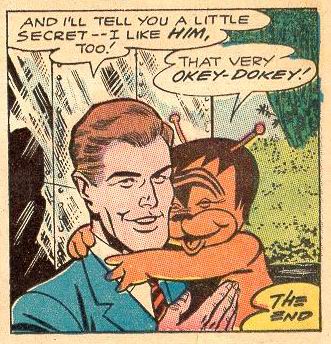
As the picture above hints, Zook was something of a cloying, saccharine character. Although similar to the pets that many DC heroes had at one point or another, there was really nothing quite like him.
Detective #326, the last issue to feature the Martian Manhunter, introduced the Idol Head of Diabolu, a transparent plot device that guaranteed continuing stories. The idea was that once opened, the Idol Head would release an evil upon the world every full moon. This of course guaranteed monthly adventures for the Martian Manhunter, who would have them in a new location as the lead feature in House of Mystery, starting with that comic's issue #143. In addition, that issue saw the apparent death of John Jones, thus cutting him loose from the detective job.

